Oppo R1 - A Dual-SIM 8MP Shooter
The R1 is the midrange offering from the Chinese phone maker, Oppo. Equipped with a 5-inch 720p display and an 8-megapixel rear camera, is the R1 worth considering over other value-oriented 5-inch smartphones in the market? We find out in this review.
By HardwareZone Team -
Overview
While Xiaomi relies heavily on social media and flash sales to drum up attention for its smartphones, Oppo takes a relatively muted approach by partnering with local distributors to sell its phones at fixed retail prices. Oppo started selling three smartphones - the 5.9-inch N1 (flagship), the 5-inch R1 (midrange) and the 4.7-inch Find 5 Mini (entry-level) on March 7.
We've reviewed the N1 which we found to be quite impressive in terms of image quality, battery life and its unique ability to flash different ROMs. However, the lack of 4G LTE connectivity, no memory card slot, expensive price tag and limited memory space for apps were major drawbacks. How about the R1?
The R1 is quite different from the N1 in terms of its target market segment. It is specifically positioned as a midrange smartphone with dual-SIM capability, a decent set of specs such as an 8-megapixel rear camera and the standard suite of ColorOS features. Where does the Oppo R1 stand in the sea of affordable 5-inch smartphones today? Read on to find out more.

Is this an Apple iPhone or Sony Xperia knock-off? No, it is the Oppo R1.
Design and Handling
Oppo claims the design of the R1 is inspired by the pureness and shine of diamonds; it has gone through 6 months of adjustment and 13 molds of amelioration. As tedious and exquisite the craftsmanship may seem, we think Oppo took a leaf out of Sony's book.

We spot some similarities between the Oppo R1 (left) and the Sony Xperia Z2 (right) such as the use of rear glass panel and the placement of the camera lens.
For the most part, the R1 is undeniably similar to the Sony Xperia Z2/Z1/Z Ultra/Z with its angular stature and rear glass panel although both phone makers differ on the type of glass used. The 0.55mm Corning Gorilla Glass 3 on the R1 is polished with 42 procedures into a gleaming finish while Sony uses tempered glass with a layer of anti-shatter film for the Xperia smartphones.
As expected with any glass surface, the rear of the R1 is covered in a huge mess of fingerprints and smudges within minutes of handling it. It is exceptionally unsightly on the R1 to the extent that we kept a cleaning cloth close at hand to clean it whenever we use the phone. If you cannot tolerate the sight of fingerprints and smudges on the rear glass panel, we recommend getting a case for the R1. Even that might not be an easy task considering Oppo is still a new brand in the local retail channel, so case options can be limited - unless you buy it from an overseas e-store.

After a few minutes of handling, the rear of the Oppo R1 turns into a mess of fingerprints and smudges.
While Sony's OmiBalance design utilizes a skeleton frame made of tough glass fibre polyamide, Oppo deploys an aluminum magnesium alloy frame on the R1 which is more solid and has a premium look. Overall, the handling of the R1 is good as it is rather slim at 7.1mm and weighs 141g. In comparison, the Motorola Moto G weighs 143g and has a side profile of 6.0 ~ 11.6mm. The 158g Xiaomi Redmi is thicker at 9.9mm.

The power button is placed on the left side of the Oppo R1, which strays from the usual practice of putting it on the right.

The bottom left section of the Oppo R1 stores the dual-SIM card tray.
Most Android smartphones such as the Huawei Ascend P6, the Moto G and Redmi have their power button placed on the right side with the volume rocker. Oppo decided to be different by placing the power button on the left side. While we think that this isn't a deal breaker, some users might take a little time to adapt to the change..
The standard Android navigation buttons (menu, home, back) are located just below the 5-inch display. Unlike the Redmi which has no backlighting for the capacitive buttons, Oppo gives you the option to turn it on (all the time or for 6 seconds) or turn it off if you think it is unnecessary or further preserve power draw.
Features
5-inch HD Display
The R1 comes with a 5-inch 720p display which is pretty standard for a midrange phone. While it cannot compete with the recent 5-inch Android flagship smartphones in pixel density and sharpness, the R1's resolution on the screen is plenty dense enough for most usage scenarios such as web browsing, watching videos and browsing photos. The bezels around the screen are neither too thick or too thin; we found our finger can rest at the side of the screen without interfering with the navigation.
ColorOS - Gesture Panel
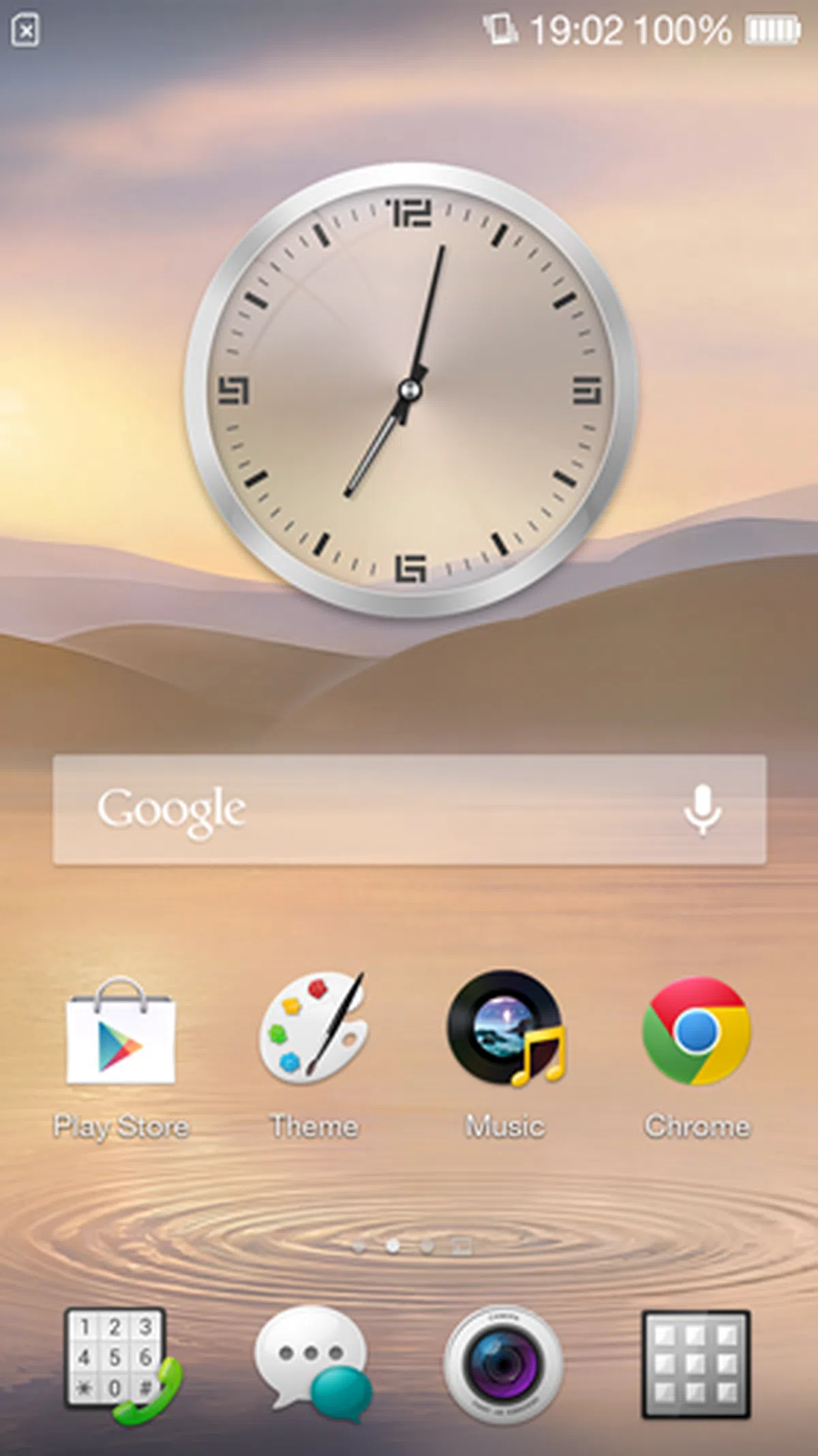 | 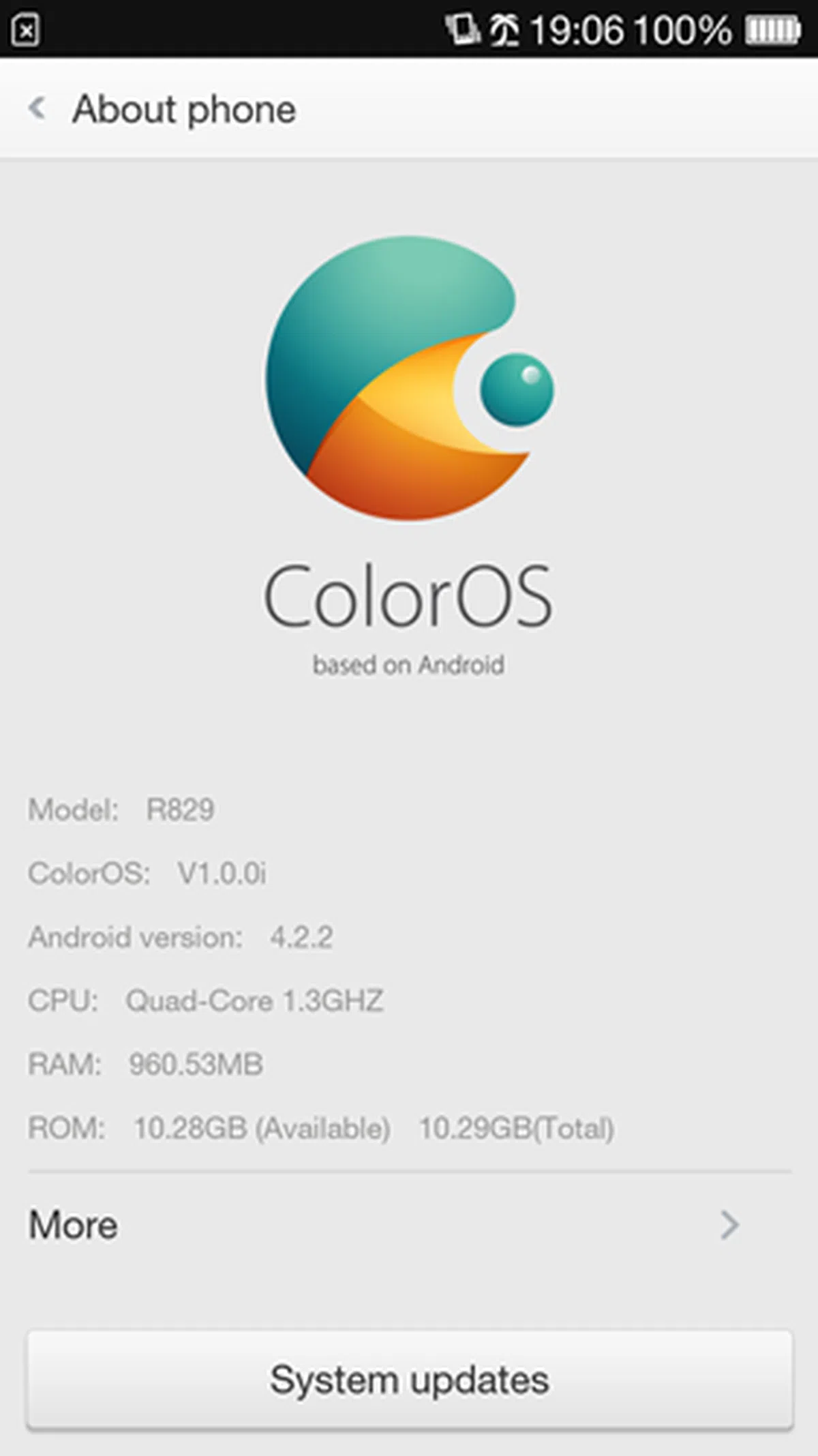 |
Similar to Xiaomi's MIUI OS, Oppo also took the time and effort to develop an entirely different interface on top of the Android source code. For the R1, the ColorOS V1.0.0i is based on Android 4.2.2 version. Its more recent devices such as the Find 7A, is powered by ColorOS V1.2.0i which is based on Android 4.3 Jelly Bean.
We checked with Oppo Singapore on the differences between the two versions. The company responded by saying that the newer V1.2.0i will have upgrades and customization in the dial pad user interface, graphics API, Bluetooh Smart, Wi-FI API, camera interface and email interface.
When queried on whether there are plans to standardize all Oppo smartphones to the same ColorOS versions, a company spokesperson told us that each ColorOS version is customized specifically to either enhance the user experience or rectify issues for different devices. Oppo has no plans to standardize all versions across all products. Following its current path allows further optimization efforts to improve the user experience of the ColorOS on different devices. As for a ColorOS version based on Android 4.4 KitKat, we were told that Oppo currently has plans in the pipeline for the Find 7a and Find 7.
ColorOS is developed to provide a seamless way of navigation on Oppo's phones. One of the key features of ColorOS is the use of gestures on the lock screen and home screen as shortcuts to open apps or carry out certain functions.
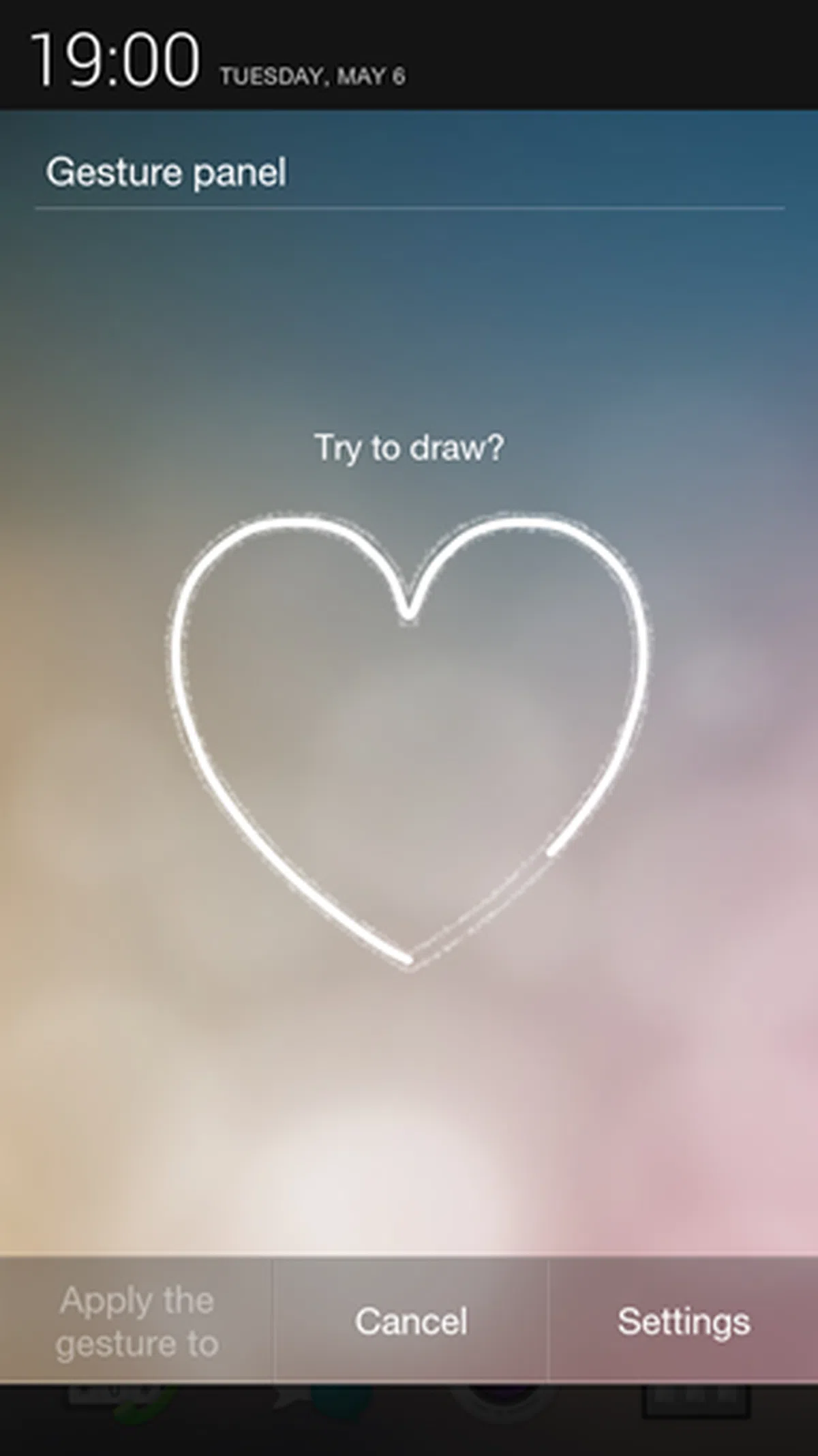 | 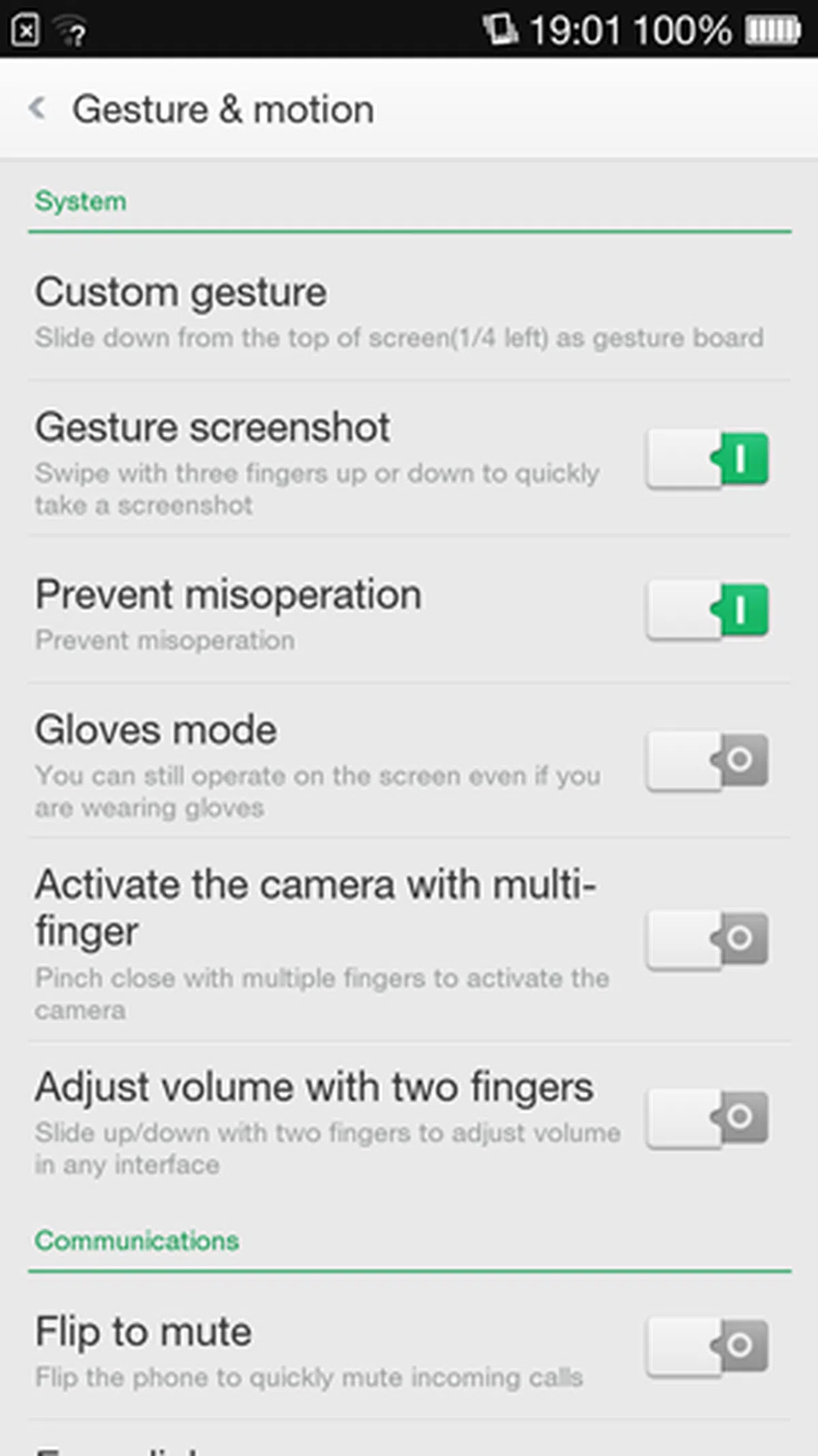 | 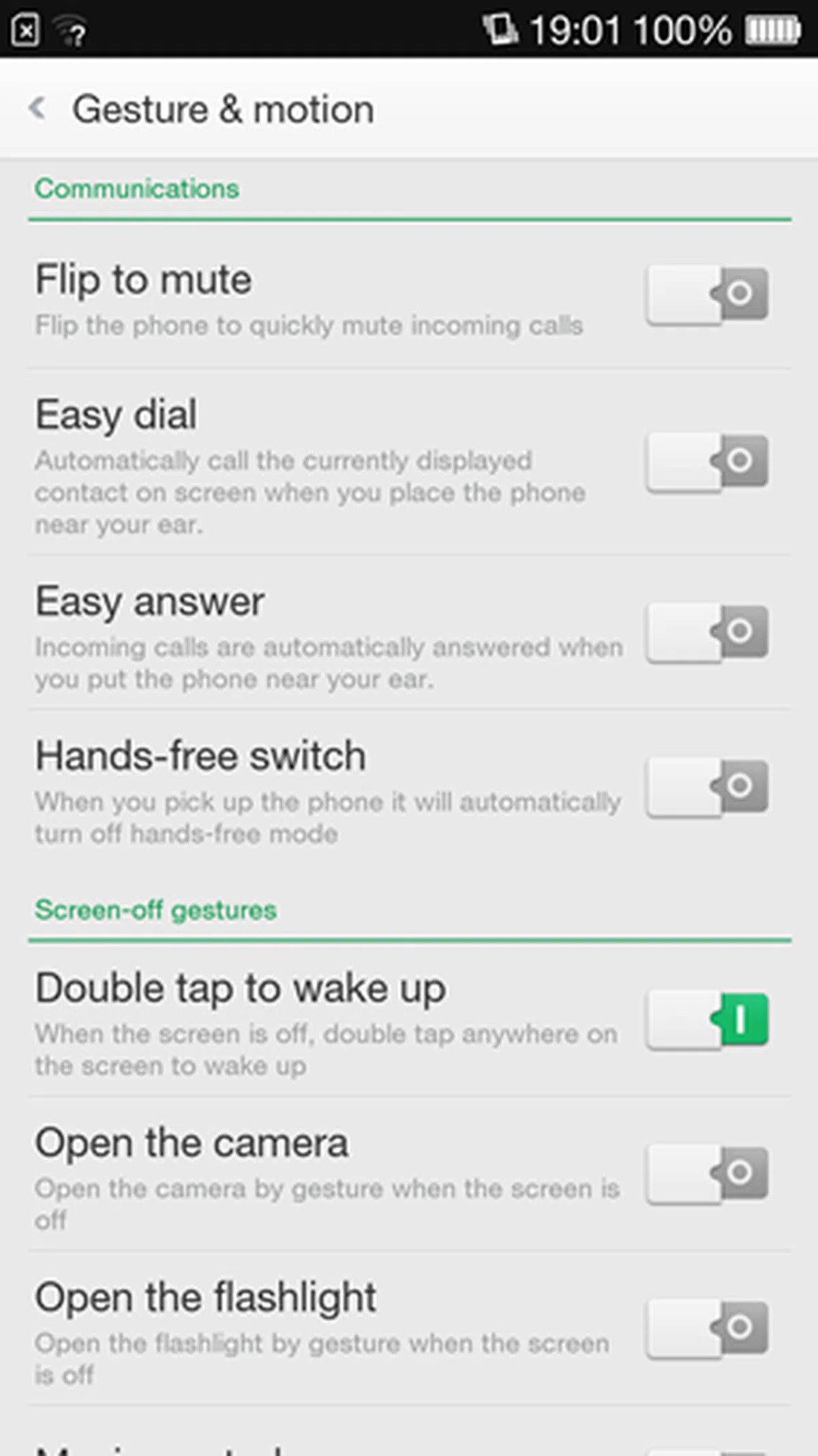 |
To start things off, screen-off gestures can be executed on the lock screen to jump straight into apps. By default, you can access the Camera app off by drawing a circle or activate the camera flash as a flashlight by drawing a V when the screen is off. There are other screen-off gestures that you can execute such as:
- Double tap to wake up the screen. (This is similar to LG, HTC and Nokia's implementations)
- Two finger slide down to play or pause the music.
- Left arrow to go to previous track
- Right arrow to go to next track
You can set other screen-off gestures of your own; you can choose to call Home with an upward arrow, slide left to access to Facebook and activate Google Maps by drawing a M gesture. This navigation is extended to the home screen where you access the Gesture Panel by swiping down from the top left corner of the screen.
As with screen-off gestures, you can customize your own. Our favorites include accessing Facebook by drawing a "F", WhatsApp by a "W', Instagram by an "I" and Google Hangouts by a "H". We were told by Sean Deng, Oppo's Managing Director for Singapore, that custom gestures like these enable users to jump between apps effortlessly instead of pressing Home and looking for the particular app.
For example, you might be discussing with your friends on where to go for dinner tonight on your messaging app. One of your friends suggests a particular restaurant, but you have no idea where it is. Instead of pressing the Home button and search for the web browser or Google Maps app, you can swipe down from the top left corner of your group chat window and draw the "M" gesture to access Maps. After you have figured out the location and the transport route options to the restaurant, you can press the Back button to go back straight into the group chat window.
ColorOS takes up about 5GB of storage space on the R1 that's equipped with 16GB of built-in storage, leaving about 10.28GB of available storage space for installing apps and storing multimedia content (photos and videos). The lack of a memory card slot may turn off power users, but 10GB storage space is manageable for a mid-tier phone.
Performance Benchmarks
The R1 is powered by the MediaTek MT6582 quad-core 1.3GHz processor and 1GB RAM. We will be comparing the R1 against the other phones of its class such as the ASUS ZenFone 5 and Huawei Ascend P6. We included the LG Nexus 5 and Xiaomi Mi 3 because their price points are close to that of the R1.
Quadrant Results
Quadrant evaluates a device's CPU, memory, I/O and 3D graphics performances. Compared to the ZenFone 5, the R1 scored 20% lower in the Quadrant benchmark. The R1, however, fared 40% better than the one-year-old Ascend P6.

3DMark (2013)
Originally developed as a PC benchmarking tool, 3DMark is now expanded to support multiple platforms including Android OS. The Ice Storm benchmark is designed for smartphones, mobile devices and ARM architecture computers.
For an in-depth understanding of 3DMark for Android, do head over to our article, "3DMark - Android Device GPU Performance Review." In a nutshell, 3DMark consists of three test sections:
3DMark Ice Storm is an OpenGL ES 2.0 benchmark test that uses fixed off-screen rendering at 720p then scales the output to fit the native display resolution of your device. Ice Storm includes two graphics tests designed to stress the GPU performance of your device and a physics test to stress its CPU performance.
3DMark Ice Storm Extreme raises the off-screen rendering resolution to 1080p and uses higher quality textures and post-processing effects to create a more demanding load for the latest smartphones and tablets.
3DMark Ice Storm Unlimited is used to make chip-to-chip comparisons of different chipsets, CPUs and GPUs, without vertical sync, display resolution scaling and other operating system factors affecting the result.

Similar to the Quadrant benchmark, the R1 fared better than the Ascend P6 and worse than the ZenFone 5. The two flagship devices - the Nexus 5 and Mi 3 - are obviously in a league of their own with top of the line Snapdragon 800 processors.
SunSpider Javascript
SunSpider Javascript measures the browsing performance of a device. It not only takes into consideration the underlying hardware performance, but also assesses how optimized a particular platform is at delivering a high-speed web browsing experience.

We saw a similar outcome in the SunSpider Javascript benchmark where the R1 is sandwiched between the ZenFone 5 and Ascend P6.
Real World Usage Experience
Synthetic benchmarks aside, the R1 was snappy in its daily operation. Web browsing was smooth with no stutters.
Imaging Performance
The R1 is equipped with an 8-megapixel rear camera with an aperture of f/2.0 and BSI CMOS sensor. The imaging hardware is on-par with many phones of its class including the ZenFone 5 and Ascend P6, and can possibly rival the Nexus 5 on paper too. Its front-facing camera is no slouch either; it has a 5-megapixel sensor with wide angle lens which makes it perfect for consumers who like to take selfies.

The image quality is average; we spotted slight image artifacts in the darker areas of the photo. Colors are pleasing though.
Battery Performance
Our standard battery test for mobile phones includes the following parameters:
• Looping a 800 x 480-pixel video with screen brightness and volume at 100%
• Wi-Fi and Bluetooth connectivity turned on
• Constant data streaming through email and Twitter


The R1 managed to last slightly over 5 hours, which placed it in the second last position in terms of battery mileage. Despite having a slightly larger battery capacity and the same display size/resolution, the R1 lasted about 6% (19 minutes) lesser than the ZenFone 5. Even the Nexus 5 with its higher display resolution (1080p) fared better in the battery test. Its lower-than-expected battery mileage could be attributed to its high power consumption. At 1.95W, the R1 ranks second to the Mi 3.
Portability
We measure the portability of a device by calculating its battery life to (weight x volume) ratio. Even though it has an average battery life, the R1 ranked second in our Portability Index due to its super slim 7.1mm form factor.

Conclusion
Priced at S$519, the R1 finds itself in a very competitive market segment where competing phones cost lower and deliver better performance. What sets the R1 apart is the ColorOS, which delivers a unique user experience with the Gesture Panel. Using gestures and drawings to launch apps or access certain functions, Oppo's Gesture Panel may potentially change the way how Android users navigate the interface. Other than the Gesture Panel, there is not much going for the R1.
Its direct competitor will be the upcoming ASUS ZenFone 5, which is also a dual-SIM device that has a fine combination of good design, solid build quality, great handling and imaging performance packed for just S$249. While the price is half that of the R1, you have to be mindful of the occasional sluggish performance in the ZenFone 5. Another excellent option is Xiaomi's Mi 3, which provides plenty of bang for your buck. At S$339, you get endless customization options on the software front and better overall performance than the R1, improved imaging quality and a Full-HD screen.
As a mid-range phone, the Oppo R1 actually offers a good build with a decent set of features. However, among the crowded market space, it doesn't excel in any particular manner and with its high asking price, its difficult for us to recommend the R1 over other options. You would think it might have 4G LTE support, but unfortunately it doesn't. Given its predicament, it could ideally appeal to users who who would like to have a unique phone to stand out from the sea of other popular models, but that's a niche group of people.
Our articles may contain affiliate links. If you buy through these links, we may earn a small commission.